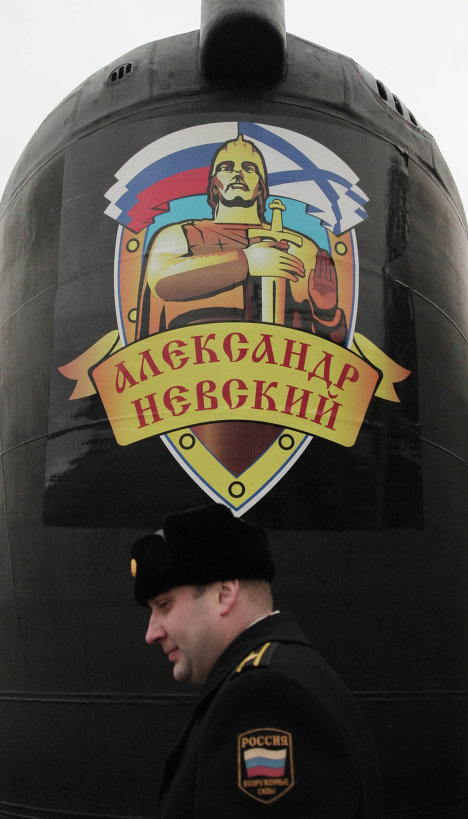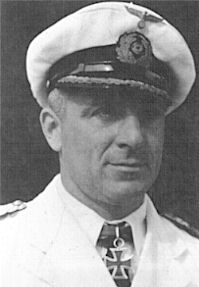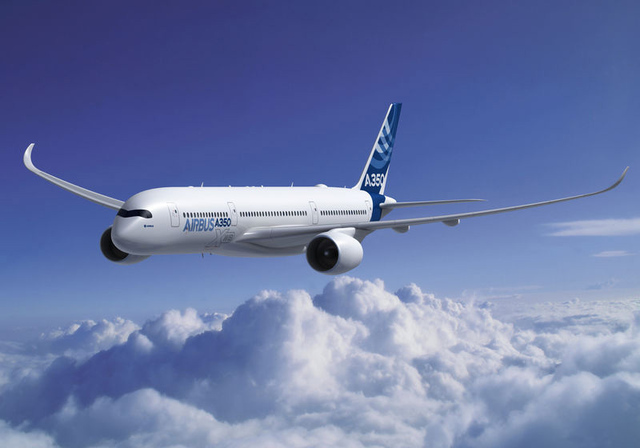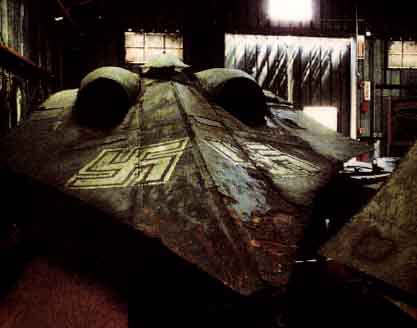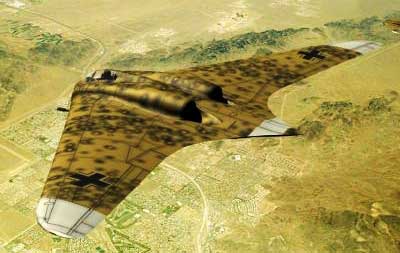Horten Ho 229 Flying Wing
Role: Fighter/Bomber
Manufacturer :Gothaer Waggonfabrik
Designer: Horten brothers
First flight: 1 March 1944
Primary user: Luftwaffe
Number built: 3
The Horten H.IX, RLM designation Ho 229 (often wrongly called the Gotha Go 229 due to the identity of the chosen manufacturer of the aircraft) was a German prototype fighter/bomber designed by Reimar and Walter Horten and built by Gothaer Waggonfabrik late in World War II. It was the first pure flying wing powered by jet engines.
It was given the personal approval of Reichsmarschall Hermann Göring, and was the only aircraft to come close to meeting his "3×1000" performance requirement of 1943 (see later)
Since the appearance of the B-2 Spirit flying wing stealth bomber in the 1990s, its similarities in role and shape to the Ho 229 has led many to retrospectively describe the Ho 229 as "the first stealth bomber".
A static reproduction of the only surviving Ho 229 prototype, the Ho 229 V3, in American hands since the end of World War II was later tested by the US military who found the basic shape and paint composition of the mock copy would provide for 20% reduction in detection range against the Chain Home radar of the 1940s, but no significant stealth benefit against most other contemporary radar systems.
Design and development
In the early 1930s, the Horten brothers had become interested in the flying wing design as a method of improving the performance of gliders. The German government was funding glider clubs at the time because production of military and even motorized aircraft was forbidden by the Treaty of Versailles after World War I.
The flying wing layout removes any "unneeded" surfaces and, in theory at least, leads to the lowest possible weight. A wing-only configuration allows for a similarly performing glider with wings that are shorter and thus sturdier, and without the added drag of the fuselage. The result was the Horten H.IV.
In 1943, Göring issued a request for design proposals to produce a bomber that was capable of carrying a 1,000 kilograms (2,200 lb) load over 1,000 kilometres (620 mi) at 1,000 kilometres per hour (620 mph); the so-called "3 X 1000 project".
Conventional German bombers could reach Allied command centers in Great Britain, but were suffering devastating losses from Allied fighters. At the time, there was no way to meet these goals — the new Junkers Jumo 004B turbojets could provide the required speed, but had excessive fuel consumption.
The Hortens concluded that the low-drag flying wing design could meet all of the goals: by reducing the drag, cruise power could be lowered to the point where the range requirement could be met. They put forward their private project, the H.IX, as the basis for the bomber. The Government Air Ministry (Reichs Luftfahrt Ministerium) approved the Horten proposal, but ordered the addition of two 30 mm cannons, as they felt the aircraft would also be useful as a fighter due to its estimated top speed being significantly higher than that of any Allied aircraft.

The H.IX was of mixed construction, with the center pod made from welded steel tubing and wing spars built from wood. The wings were made from two thin, carbon-impregnated plywood panels glued together with a charcoal and sawdust mixture. The wing had a single main spar, penetrated by the jet engine inlets, and a secondary spar used for attaching the elevons. It was designed with a 7g load factor and a 1.8 x safety rating; therefore, the aircraft had a 12.6g ultimate load rating.
The wing's chord/thickness ratio ranged from 15% at the root to 8% at the wingtips. The aircraft utilized retractable tricycle landing gear, with the nose gear on the first two prototypes sourced from a He 177's tail wheel system, with the third prototype using an He 177A main gear wheel rim and tire on its custom-designed nose gear strut work and wheel fork.
A drogue parachute slowed the aircraft upon landing. The pilot sat on a primitive ejection seat. It was originally designed for the BMW 003 jet engine, but that engine was not quite ready and the Junkers Jumo 004 engine was substituted. nd more graceful control of yaw than would a single spoiler system.[1]
The first prototype H.IX V1, an unpowered glider with fixed tricycle landing gear, flew on 1 March 1944. Flight results were very favorable, but there was an accident when the pilot attempted to land without first retracting an instrument-carrying pole extending from the aircraft. The design was taken from the Horten brothers and given to Gothaer Waggonfabrik. The Gotha team made some changes: They added a simple ejection seat, dramatically changed the undercarriage to enable a higher gross weight, changed the jet engine inlets, and added ducting to air-cool the jet engine's outer casing, so as to prevent damage to the wooden wing.
The H.IX V1 was followed in December 1944 by the Junkers Jumo 004-powered second prototype H.IX V2; the BMW 003 engine was preferred, but unavailable. Göring believed in the design and ordered a production series of 40 aircraft from Gothaer Waggonfabrik with the RLM designation Ho 229, even though it had not yet taken to the air under jet power. The first flight of the H.IX V2 was made in Oranienburg on 2 February 1945.
All subsequent test flights and development were done by Gothaer Waggonfabrik. By this time, the Horten brothers were working on a turbojet-powered design for the
Amerika Bomber contract competition, and did not attend the first test flight. The test pilot was Leutnant Erwin Ziller. Two further test flights were made between 2 and 18 February 1945. Another test pilot used in the evaluation was Heinz Scheidhauer.
The H.IX V2 reportedly displayed very good handling qualities, with only moderate lateral instability (a typical deficiency of tailless aircraft). While the second flight was equally successful, the undercarriage was damaged by a heavy landing caused by Ziller deploying the brake parachute too early during his landing approach. There are reports that during one of these test flights, the H.IX V2 undertook a simulated "dog-fight" with a Messerschmitt Me 262, the first operational jet fighter and that the H.IX V2 outperformed the Me 262.
Cockpit
Two weeks later, on 18 February 1945, disaster struck during the third test flight. Ziller took off without any problems to perform a series of flight tests. After about 45 minutes, at an altitude of some 800 m, one of the Jumo 004 turbojet engines developed a problem, caught fire and stopped. Ziller was seen to put the aircraft into a dive and pull up several times in an attempt to restart the engine and save the precious prototype.
Ziller undertook a series of four 360-degree turns with the wings banked 20 degrees. Ziller did not use his radio or eject from the aircraft. He may already have been unconscious as a result of the fumes from the burning engine. The aircraft crashed just outside the boundary of the airfield. Ziller was thrown from the aircraft on impact and died from his injuries two weeks later. The prototype aircraft was completely destroyed.
Despite this setback, the project continued with sustained energy. On 12 March 1945, the Ho 229 was included in the Jäger-Notprogramm (Emergency Fighter Program) for accelerated production of inexpensive "wonder weapons". The prototype workshop was moved to the Gothaer Waggonfabrik (Gotha) in Friedrichroda. In the same month, work commenced on the third prototype, the Ho 229 V3.
The V3 was larger than previous prototypes, the shape being modified in various areas, and it was meant to be a template for the pre-production series Ho 229 A-0 day fighters, of which 20 machines had been ordered. The V3 was meant to be powered by two Jumo 004C engines with 10% greater thrust each than the earlier Jumo 004B production engine used for the Me 262A and Ar 234B, and could carry two MK 108 30mm cannon in the wing roots. Work had also started on the two-seat Ho 229 V4 and Ho 229 V5 night-fighter prototypes, the Ho 229 V6 armament test prototype, and the Ho 229 V7 two-seat trainer.
During the final stages of the war, the U.S. military initiated Operation Paperclip, an effort to capture advanced German weapons research, and keep it out of the hands of advancing Soviet troops.
A Horten glider and the Ho 229 V3, which was undergoing final assembly, were secured for sending to the United States for evaluation. En route, the Ho 229 spent a brief time at RAE Farnborough in the UK while it was considered if British jet engines could be fitted, but the mountings were incompatible due to the available British engines of the time only using centrifugal compressors with their comparatively larger diameter compressor sections, and not the slimmer axial-flow turbojet power plants the Germans were using.
When U.S. troops captured Gotha's Friedrichsroda plant on April 14, 1945, the partly completed Ho 229 V3 was found and transported to the U.S. and, as shown here, was held in storage at NASM's Silver Hill facility.
Survivors
The only surviving Ho 229 airframe, the V3 — and indeed, the only surviving German jet prototype still in existence — is at the Smithsonian National Air and Space Museum's Paul E. Garber Restoration Facility in Suitland, Maryland. In December, 2011, the National Air and Space Museum had moved the Ho 229 into the active restoration area of the Garber Restoration Facility and is currently being reviewed for full restoration and display. The center section of the V3 prototype was meant to be moved to the Smithsonian NASM's Steven F. Udvar-Hazy Center in late 2012 to commence a detailed examination of it before starting any serious conservation/restoration efforts
Stealth technology
After the war, Reimar Horten said he mixed charcoal dust in with the wood glue to absorb electromagnetic waves (radar), which he believed could shield the aircraft from detection by British early warning ground-based radar that operated at 20 to 30 MHz (top end of the HF band), known as Chain Home.
A jet-powered flying wing design such as the Horten Ho 229 will have a smaller radar cross-section than conventional contemporary twin-engine aircraft. This is because the wings blended into the fuselage and there were no large propeller disks or vertical and horizontal tail surfaces to provide a typical identifiable radar signature.
Engineers of the Northrop-Grumman Corporation had long been interested in the Ho 229, and several of them visited the Smithsonian Museum's facility in Silver Hill, Maryland in the early 1980s to study the V3 airframe. A team of engineers from Northrop-Grumman ran electromagnetic tests on the V3's multilayer wooden center-section nose cones. The cones are three quarters of an inch (19 mm) thick and made up of thin sheets of veneer. The team concluded that there was indeed some form of conducting element in the glue, as the radar signal attenuated considerably as it passed through the cone.
 Northrop-built reproduction
Northrop-built reproduction
In early 2008, Northrop-Grumman paired up television documentary producer Michael Jorgensen, and the National Geographic Channel to produce a documentary to determine whether the Ho 229 was, in fact, the world's first true "stealth" fighter-bomber. Northrop-Grumman built a full-size non-flying reproduction of the V3, constructed to match the aircraft's radar properties. After an expenditure of about US$250,000 and 2,500 man-hours, Northrop's Ho 229 reproduction was tested at the company's classified radar cross-section (RCS) test range at Tejon, California, where it was placed on a 15-meter (50 ft) articulating pole and exposed to electromagnetic energy sources from various angles, using the same three frequencies in the 20–50 MHz range used by the Chain Home in the mid-1940s.

RCS testing showed that a hypothetical Ho 229 approaching the English coast from France flying at 885 kilometres per hour (550 mph) at 15–30 metres (49–98 ft) above the water would have been visible at a distance of 80% that of a Bf 109. This implies a frontal RCS of only 40% that of a Bf 109 at the Chain Home frequencies. The most visible parts of the aircraft were the jet inlets and the cockpit, but caused no return through smaller dimensions than the CH wavelength. Given the high-speed capabilities of the aircraft it would have given the British defences just two and a half minutes to respond, which would not have been enough time. It is believed that, if deployed in great numbers, the Ho 229 could have changed the course of the war.
With testing complete, the reproduction was donated by Northrop-Grumman to the San Diego Air and Space Museum.
Link to doco on Youtube:
http://www.youtube.com/watch?v=NaJzKjtjZnY
The television documentary, Hitler's Stealth Fighter (2009), produced by Myth Merchant Films, featured the Northrop-Grumman full-scale Ho 229 model as well as CGI reconstructions depicting a fictional wartime scenario where Ho 229s were operational in both offensive and defensive roles.
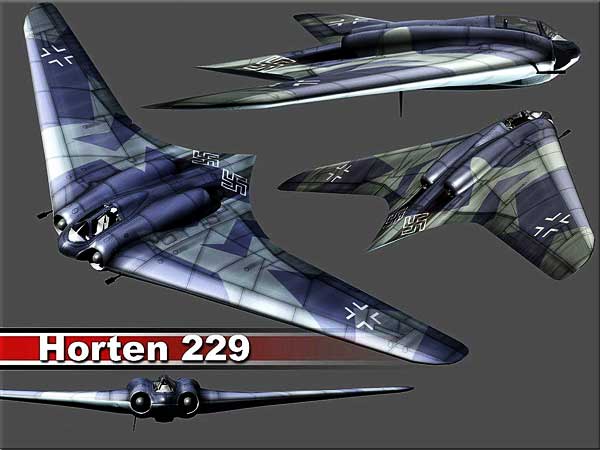
Breaking news June 2014:
Data from The Great Book of Fighters:
General characteristics
Crew: 1
Length: 7.47 m (24 ft 6 in)
Wingspan: 16.76 m (55 ft 0 in)
Height: 2.81 m (9 ft 2 in)
Wing area: 50.20 m² (540.35 ft²)
Empty weight: 4,600 kg (10,141 lb)
Loaded weight: 6,912 kg (15,238 lb)
Max. takeoff weight: 8,100 kg (17,857 lb)
Powerplant: 2 × Junkers Jumo 004B turbojet, 8.7 kN (1,956 lbf) each
Performance
Maximum speed: 977km/h (607 mph) at 12,000 metres (39,000 ft)
Service ceiling: 16,000 m (52,000 ft)
Rate of climb: 22 m/s (4,330 ft/min)
Wing loading: 137.7 kg/m² (28.2 lb/ft²)
Thrust/weight: 0.26
Armament
Guns: 4 × 30 mm MK 108 cannon
Rockets: R4M rockets
Bombs: 2 × 500 kilograms (1,100 lb) bombs
See also [edit]
Sounces: Internet, Wikipedia, at al







